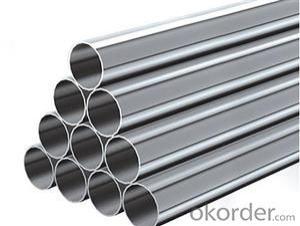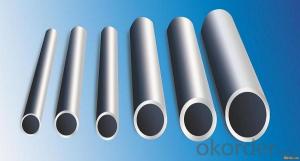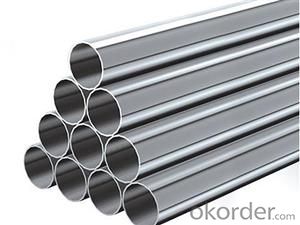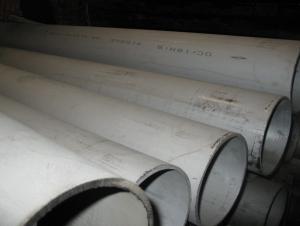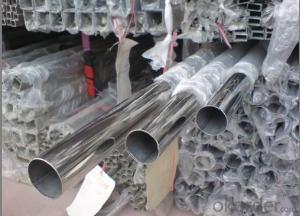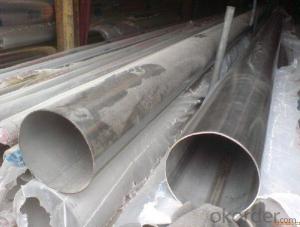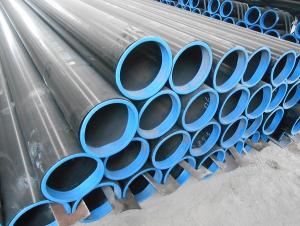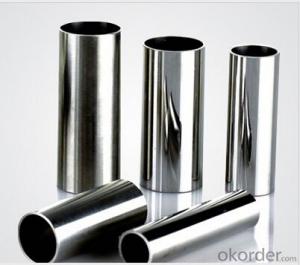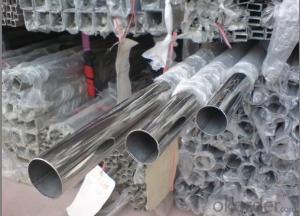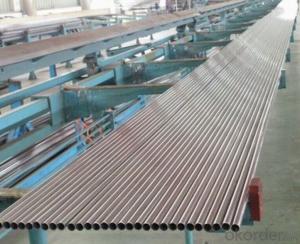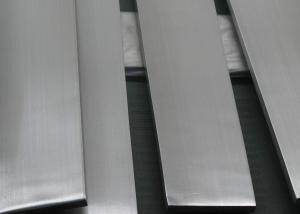Oil Gas Sewage Transport Usage Hot Rolled Stainless Steel Pipe
- Loading Port:
- Tianjin
- Payment Terms:
- TT OR LC
- Min Order Qty:
- 35 m.t.
- Supply Capability:
- 5000 m.t./month
OKorder Service Pledge
OKorder Financial Service
You Might Also Like
Specification
1.Structure of Hot Rolled Stainless Steel Pipe:
Seamless pipe is formed by drawing a solid billet over a piercing rod to create the hollow shell. As the manufacturing process does not include any welding, seamless pipes are perceived to be stronger and more reliable. Historically seamless pipe was regarded as withstanding pressure better than other types, and was often more easily available than welded pipe.
2.Main Features of the Hot Rolled Stainless Steel Pipe:
• High manufacturing accuracy
• High strength
• Small inertia resistance
• Strong heat dissipation ability
• Good visual effect
• Reasonable price
3.Hot Rolled Stainless Steel PipeSpecification:
Standard | GB, DIN, ASTM ASTM A106-2006, ASTM A53-2007 |
Grade | 10#-45#, 16Mn 10#, 20#, 45#, 16Mn |
Thickness | 8 - 33 mm |
Section Shape | Round |
Outer Diameter | 133 - 219 mm |
Place of Origin | Shandong, China (Mainland) |
Secondary Or Not | Non-secondary |
Application | Hydraulic Pipe |
Technique | Cold Drawn |
Certification | API |
Surface Treatment | factory state or painted black |
Special Pipe | API Pipe |
Alloy Or Not | Non-alloy |
Length | 5-12M |
Outer Diameter | 21.3-610mm |
Grade | 20#, 45#, Q345, API J55, API K55, API L80, API N80, API P110, A53B |
Standard | ASME, ASTM |
1) Material:20#(ASTM A 106/A53 GRB.API5LGRB,GB),45#,16Mn,10#.
2) Specification range:OD:21.3-610mm,WT:6-70mm,length:6-12m or according to the requirement of clients.
3) Excutive standards:GB,ASME API5L.ASTM A 106/A53,Despite of the above standards,we can also supply seamless steel pipe with standard of DIN,JIS,and so on,and also develop new products according to the requirements of our clients!
4) Surface:black lacquered,varnish coating or galvanized.
5) Ends:Beveled or square cut,plastic capped,painted.
6) Packing:bundles wrapped with strong steel strip,seaworthy packing.
4.Packaging & Delivery
Packaging Details: | seaworthy package,bundles wrapped with strong steel strip |
Delivery Detail: | 50-60days after received 30%TT or Original LC |
5.FAQ of Hot Rolled Stainless Steel Pipe:
How is the quality of your products?
Our products are manufactured strictly according to national and internaional standard, and we take a test on every pipe before delivered out. If you want see our quality certifications and all kinds of testing report, please just ask us for it.
Guaranteed: If products’ quality don’t accord to discription as we give or the promise before you place order, we promise 100% refund.
②How about price?
Yes, we are factory and be able to give you lowest price below market one, and we have a policy that “ for saving time and absolutely honest business attitude, we quote as lowest as possible for any customer, and discount can be given according to quantity”,if you like bargain and factory price is not low enough as you think, just don’t waste your time.Please trust the quotation we would give you, it is professional one.
③Why should you chose us?
Chose happens because of quality, then price, We can give you both.Additionally, we can also offer professional products inquiry, products knowledge train(for agents), smooth goods delivery, exellent customer solution proposals.Our service formula: good quality+good price+good service=customer’s trust
SGS test is available, customer inspection before shipping is welcome, third party inspection is no problem.
Any question, pls feel free to contact us !
6.Hot Rolled Stainless Steel Pipe Images:
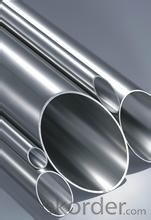
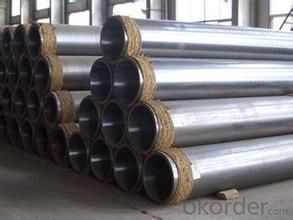
7. Company Information:
CNBM International Corporation (CNBM International) is the most important trading platform of CNBM Group Corporation, a state-owned company under the direct supervision of State-owned Assets Supervision and Administration Commission of the State Council.
Since 2004, the trading volume of CNBM International has been doubled in 5 successive years owing to the support of superior corporations and effort of all staff. Meanwhile, we have established strategic partnerships with hundreds of domestic manufacturers and sound business relations with clients from over 120 countries. Currently, we have wholly-owned overseas subsidiaries and branches in 5 countries with a view to realize localization, which also represents an essential progress in our globalization target.
In line with the business, CNBM International launched E-business platform Okorder.com.Our goal is to transform CNBM International into the global leading brand in building materials industry within 3 to 5 years through innovation and reform, by strengthening the overall management of supply chain, developing and cultivating both domestic and overseas market, improving the procedure and information system, enhancing the ability to organize resources and to provide value-added services under a professional team and a learning organization.
- Q: Can stainless steel pipes be insulated with Teflon?
- Yes, stainless steel pipes can be insulated with Teflon. Teflon, also known as polytetrafluoroethylene (PTFE), is a versatile material that is commonly used for its nonstick properties and resistance to heat and chemicals. It is an excellent choice for insulating stainless steel pipes as it can provide thermal insulation, protect against corrosion, and prevent heat loss or gain. Teflon insulation can also reduce condensation or moisture buildup on the pipe surface. Additionally, Teflon's low friction coefficient allows for smooth flow of fluids through the pipes, making it suitable for a variety of applications in industries such as food processing, pharmaceuticals, and chemicals.
- Q: About stainless steel welding deformation
- In fact, the deformation of stainless steel and carbon steel caused little difference, but the deformation is greater than carbon steel, the treatment method is the same.(1) using smaller welding rod and smaller current.(2) correcting welding sequence;(3) before welding, clamp the weldment to avoid warping.(4) avoid excessive cooling or preheating of base metal.(5) the welding penetration is low.(6) reduce weld gap and reduce slotting degree.(7) pay attention to the welding size, not to make the welding bead too big.(8) pay attention to the fixed measures to prevent deformation.
- Q: How do you prevent corrosion in stainless steel pipes?
- To prevent corrosion in stainless steel pipes, it is important to regularly clean and maintain them. This can be done by removing any dirt, debris, or contaminants that may accumulate on the surface of the pipes. Additionally, applying a protective coating or sealant can help create a barrier between the stainless steel and external elements that could cause corrosion. Regular inspections and prompt repairs of any damages or leaks are also crucial to prevent corrosion in stainless steel pipes.
- Q: What is the difference between Type 409 and Type 410 stainless steel pipes?
- Type 409 stainless steel pipes are commonly used in automotive exhaust systems due to their excellent resistance to high temperatures and corrosion. On the other hand, Type 410 stainless steel pipes are known for their higher strength and hardness, making them suitable for applications that require increased durability and resistance to wear and abrasion.
- Q: What is the difference between Type 304L and Type 316L stainless steel pipes?
- Type 304L and Type 316L stainless steel pipes are commonly chosen for a variety of uses due to their ability to resist corrosion. However, they differ in their composition and performance in specific settings. The primary distinction lies in their alloy content. Type 304L stainless steel contains 18-20% chromium and 8-12% nickel, whereas Type 316L stainless steel contains 16-18% chromium, 10-14% nickel, and 2-3% molybdenum. The inclusion of molybdenum in Type 316L enhances its corrosion resistance, particularly in environments with high chloride concentrations. As a result, Type 316L is more suitable for applications where the pipes will come into contact with seawater, brine, or other harsh chemicals. Another factor that sets them apart is their mechanical properties. Type 316L stainless steel has slightly higher tensile strength and yield strength compared to Type 304L. It also exhibits better creep and stress rupture properties, making it more appropriate for high-temperature uses. However, for most general purposes, Type 304L is still a good choice, offering excellent durability and longevity. When it comes to cost, Type 316L stainless steel pipes are typically more expensive than Type 304L due to the additional alloying elements. Therefore, the decision between the two will depend on the specific requirements of the application, taking into account factors such as the corrosive environment, temperature, and budget. Overall, while both Type 304L and Type 316L stainless steel pipes provide excellent corrosion resistance, Type 316L offers superior performance in more aggressive environments and higher temperatures. It is advisable to consult with a materials expert or engineer to determine the most suitable stainless steel pipe for a particular application.
- Q: What is the difference between 304LN and 316LN stainless steel pipes?
- The main difference between 304LN and 316LN stainless steel pipes lies in their composition and the addition of certain elements. 304LN stainless steel is an austenitic stainless steel that contains low carbon content and nitrogen. It is designed to provide improved strength and corrosion resistance compared to standard 304 stainless steel. The addition of nitrogen promotes the formation of a stable austenite phase, which enhances the material's mechanical properties. On the other hand, 316LN stainless steel is also an austenitic stainless steel but contains molybdenum and a higher nickel content compared to 304LN. The addition of molybdenum increases the material's resistance to pitting corrosion caused by chlorides and other aggressive environments. The higher nickel content further enhances the corrosion resistance and makes it suitable for more demanding applications, such as marine environments or chemical processing. In summary, while both 304LN and 316LN stainless steel pipes are austenitic and offer good corrosion resistance, the addition of molybdenum and higher nickel content in 316LN makes it more suitable for applications where enhanced corrosion resistance is required, especially in aggressive environments.
- Q: What is the difference between Sch 40 and Sch 80 stainless steel pipes?
- Sch 40 and Sch 80 stainless steel pipes differ in their wall thicknesses. Sch 40 denotes a pipe with a "Schedule 40" wall thickness, while Sch 80 refers to a pipe with a "Schedule 80" wall thickness. The schedule number signifies the approximate wall thickness of the pipe, with higher numbers indicating thicker walls. When it comes to stainless steel pipes, Sch 80 has a greater wall thickness compared to Sch 40. The variation in wall thickness leads to disparities in pressure rating and strength. Sch 80 stainless steel pipes are engineered to withstand higher pressure and are generally employed in applications where the pipe must endure heightened levels of stress or extreme conditions. Conversely, Sch 40 stainless steel pipes are typically used in less demanding situations where lower pressure ratings are acceptable. Furthermore, the increased wall thickness of Sch 80 pipes results in a smaller internal diameter in contrast to Sch 40 pipes. This reduction in internal diameter can affect the flow rate of fluids or gases through the pipe, so it is crucial to take this factor into account when selecting the appropriate pipe for a specific application. To summarize, the primary distinction between Sch 40 and Sch 80 stainless steel pipes lies in their wall thickness. Sch 80 pipes are thicker and capable of handling higher pressure and stress levels.
- Q: Are stainless steel pipes resistant to chemicals?
- Stainless steel pipes are generally resistant to chemicals, thanks to their corrosion resistance properties. This quality makes stainless steel an ideal material for various applications, including pipes that come into contact with different chemicals. The presence of high levels of chromium in stainless steel forms a protective layer on its surface, preventing it from reacting with most chemicals and corrosive substances. However, it is important to consider that the resistance of stainless steel pipes to chemicals can vary depending on the specific type and grade of stainless steel used. In certain cases, aggressive chemicals or extreme conditions may still cause corrosion or damage to stainless steel pipes. Therefore, it is always recommended to seek advice from experts or refer to chemical resistance charts for accurate information regarding the compatibility of stainless steel pipes with different chemicals.
- Q: What are the different grades of stainless steel used in pipe manufacturing?
- There are several different grades of stainless steel that are commonly used in pipe manufacturing. These grades are designated by a number system, with the most common grades being 304, 316, and 430. Grade 304 stainless steel is the most widely used and versatile grade of stainless steel. It contains a high level of chromium and nickel, which gives it excellent corrosion resistance and durability. This grade is ideal for applications where the pipe may come into contact with corrosive substances or environments, such as in chemical processing plants or marine applications. Grade 316 stainless steel is similar to grade 304, but it contains a higher level of molybdenum. This additional element enhances the grade's corrosion resistance, particularly against chlorides and other harsh chemicals. Grade 316 is often used in industries such as pharmaceuticals, food processing, and coastal areas where saltwater exposure is common. Grade 430 stainless steel is a lower-grade option compared to 304 and 316. It has a lower level of nickel and does not contain molybdenum. While it still offers good corrosion resistance in many environments, it is not as resistant to certain corrosive agents as the higher grades. Grade 430 is commonly used in applications where cost is a primary consideration, such as for exhaust systems or decorative purposes. Other grades of stainless steel, such as 201 and 409, may also be used in pipe manufacturing, depending on the specific requirements of the application. Each grade has its own unique properties and characteristics, making it important to select the appropriate grade based on the desired performance, corrosion resistance, and cost considerations.
- Q: Are stainless steel pipes suitable for mining industries?
- Yes, stainless steel pipes are widely used and suitable for the mining industry. Stainless steel is known for its excellent corrosion resistance, making it ideal for applications in harsh and corrosive environments such as mines. This resistance to corrosion is particularly important in the mining industry, where pipes are exposed to various chemicals, water, and minerals that can accelerate the corrosion process. Additionally, stainless steel pipes are highly durable and can withstand extreme temperatures, making them suitable for the demanding conditions encountered in mining operations. Furthermore, stainless steel pipes offer high strength and reliability, ensuring the safe and efficient transportation of fluids, gases, and slurries throughout the mining process. Overall, stainless steel pipes are a preferred choice in the mining industry due to their corrosion resistance, durability, and strength, making them a reliable and long-lasting option for mining operations.
Send your message to us
Oil Gas Sewage Transport Usage Hot Rolled Stainless Steel Pipe
- Loading Port:
- Tianjin
- Payment Terms:
- TT OR LC
- Min Order Qty:
- 35 m.t.
- Supply Capability:
- 5000 m.t./month
OKorder Service Pledge
OKorder Financial Service
Similar products
Hot products
Hot Searches
Related keywords
